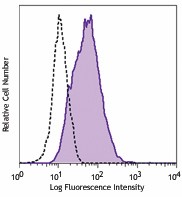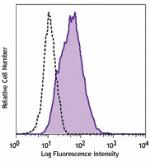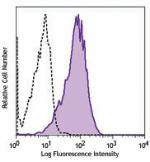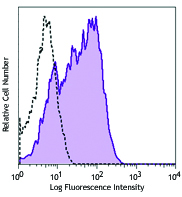- Clone
- 9D9F9 (See other available formats)
- Regulatory Status
- RUO
- Other Names
- Receptor tyrosine Kinase VEGFR-3, VEGFR3, FLT4
- Isotype
- Mouse IgG1, κ
- Ave. Rating
- Submit a Review
- Product Citations
- publications

-

HUVEC, human endothelial cells were stained with purified VEGFR3 (clone 9D9F9) (filled histogram) or mouse IgG1, κ isotype control (open histogram), followed by anti-mouse IgG PE.
| Cat # | Size | Price | Quantity Check Availability | Save | ||
|---|---|---|---|---|---|---|
| 356201 | 50 µg | 100€ | ||||
Receptor tyrosine Kinase VEGFR-3, also known as FLT4, together with VEGFR1 (FIT1) and VEGFR2 (KDR/Flk-1), are the receptors for vascular endothelial growth factors (VEGF). The VEGFR family belongs to the class II subfamily of receptor tyrosine kinases (RTKs), containing a large extracellular region which is composed of seven Ig-like domains (D1–D7), a single transmembrane, helix, and a cytoplasmic region with tyrosine kinase activity. In VEGFR-3, the fifth Ig homology domain is proteolytically cleaved which results in polypeptides that remain linked by two disulfide bonds. VEGFR-3 is widely expressed on all endothelial cells in early embryogenesis, while, in adult tissues, VEGFR-3 expression disappears from the vascular endothelial cells and is observed only on the lymphatic endothelium. VEGF-C and VEGF-D activation of VEGFR-3 plays an important role in the formation of the lymphatic vessel system. Aberrant activation or expression of VEGFR and their ligands has been implicated in tumor angiogenesis, coronary artery disease, diabetic blindness, and other diseases.
Product DetailsProduct Details
- Verified Reactivity
- Human
- Antibody Type
- Monoclonal
- Host Species
- Mouse
- Immunogen
- VEGFR extracellular domain protein
- Formulation
- Phosphate-buffered solution, pH 7.2, containing 0.09% sodium azide.
- Preparation
- The antibody was purified by affinity chromatography.
- Concentration
- 0.5 mg/ml
- Storage & Handling
- The antibody solution should be stored undiluted between 2°C and 8°C.
- Application
-
FC - Quality tested
IHC-P, IHC-F - Reported in the literature, not verified in house - Recommended Usage
-
Each lot of this antibody is quality control tested by immunofluorescent staining with flow cytometric analysis. For flow cytometric staining, the suggested use of this reagent is ≤ 1.0 µg per million cells in 100 µl volume. It is recommended that the reagent be titrated for optimal performance for each application.
- Application Notes
-
Additional reported applications (for relevant formats) include: immunohistochemistry staining of frozen or paraffin embedded sections1-3.
-
Application References
(PubMed link indicates BioLegend citation) -
- Jussila L, et al. 1998. Cancer Res. 58:1599. (IHC)
- Kilic N, et al. 2007. Blood 110:4223. (IHC)
- Folpe A, et al. 2000. Mod. Pathol. 13:180. (IHC)
- Product Citations
-
- RRID
-
AB_2561770 (BioLegend Cat. No. 356201)
Antigen Details
- Structure
- Seven Ig-like domains in the extracellular domain, a single transmembrane helix, and a cytoplasmic region with tyrosine kinase activity
- Distribution
-
Widely expressed in early embryogenesis endothelial cells, restrictly expressed on lymphatic endothelial cells in adults
- Function
- Mediates lymphangiogenesis in response to VEGF-C and VEGF-D, involved in cardiovascular development during embryogenesis
- Ligand/Receptor
- VEGF-C, VEGF-D
- Biology Area
- Cell Biology, Immunology, Signal Transduction
- Molecular Family
- Cytokine/Chemokine Receptors
- Antigen References
-
1. Tammela T, et al. 2008. Nature 454:656.
2. Partanen TA, et al. 2000. FASEB J. 14:2087.
3. Valtola R, et al. 1999. Am. J. Pathol. 154:1381.
4. Jussila L, et al. 1998. Cancer Res. 58:1599.
5. Galland F, et al. 1992. Genomics 13:475. - Gene ID
- 2324 View all products for this Gene ID
- UniProt
- View information about VEGFR-3 on UniProt.org
Related Pages & Pathways
Pages
Other Formats
View All VEGFR-3 Reagents Request Custom Conjugation| Description | Clone | Applications |
|---|---|---|
| Purified anti-human VEGFR-3 (FLT-4) | 9D9F9 | FC,IHC-P,IHC-F |
| PE anti-human VEGFR-3 (FLT-4) | 9D9F9 | FC |
| APC anti-human VEGFR-3 (FLT-4) | 9D9F9 | FC |
| TotalSeq™-A0865 anti-human VEGFR-3 (FLT-4) | 9D9F9 | PG |
| TotalSeq™-C0865 anti-human VEGFR-3 (FLT-4) Antibody | 9D9F9 | PG |
| TotalSeq™-D0865 anti-human VEGFR-3 (FLT-4) Antibody | 9D9F9 | PG |
| TotalSeq™-B0865 anti-human VEGFR-3 (FLT-4) Antibody | 9D9F9 | PG |
Customers Also Purchased
Compare Data Across All Formats
This data display is provided for general comparisons between formats.
Your actual data may vary due to variations in samples, target cells, instruments and their settings, staining conditions, and other factors.
If you need assistance with selecting the best format contact our expert technical support team.
-
Purified anti-human VEGFR-3 (FLT-4)

HUVEC, human endothelial cells were stained with purified VE... -
PE anti-human VEGFR-3 (FLT-4)

Human endothelial cell line HUVEC was stained with VEGFR3 (c... -
APC anti-human VEGFR-3 (FLT-4)

Human endothelial cell line HUVEC was stained with VEGFR3 (c... -
TotalSeq™-A0865 anti-human VEGFR-3 (FLT-4)
-
TotalSeq™-C0865 anti-human VEGFR-3 (FLT-4) Antibody
-
TotalSeq™-D0865 anti-human VEGFR-3 (FLT-4) Antibody
-
TotalSeq™-B0865 anti-human VEGFR-3 (FLT-4) Antibody
 Login / Register
Login / Register 











Follow Us